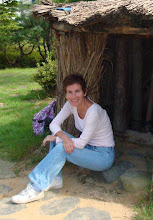RoRo's visit just happened to coincide with
Chuseok, a major harvest festival and a 3-day holiday celebrated much like the American Thanksgiving. That is, people all over Korea travel to their hometowns to visit with family and share a feast of traditional foods. This movement en masse, within a country the size of the state of Maine can present extreme travel challenges, unless you do what we did, and travel on the one day that is the actual holiday when everyone is at home honoring their ancestors and scarfing down
songpyeon (a crescent-shaped rice cake steamed on pine needles).
On
Chuseok morning we entered a nearly silent Seoul Station and boarded the KTX (Korea's

high-speed train) for a 50-minute ride south to
Daejeon, the city I call my "hometown", where we were graciously invited to share in a
Chuseok celebration with my landlord and his family. As is customary in both cultures, I took a gift to the hosts -- home-baked cookies -- and we joined in a colorful celebration of food, friends and fun. With only 2 people at the

gathering who spoke even a bit of English, the occasion was a rather quiet one, which is common for Koreans at meal time, but always a bit uncomfortable for me -- a generally gregarious guest. Yet, with some properly placed, "mmmmm's" and the final
"mah-she-tah!" (delicious!), we managed to convey our appreciation and expected to make an early exit. However, after the tables had been cleared away, and with all of us still sitting on the

floor, Mr. Kim broke out a giant board game and the formal feast was now replaced with a fun and festive game of
yut-nori. This deeply traditional game is played in teams and often treated as a social spectacle with onlookers and team members shouting loudly, encouraging each other and shooting for a certain score. Four wooden sticks that serve as a kind of dice are thrown in turn, then each team member moves their token around the board according to the scored achieved. While I've never known it to be associated with gambling, our little family game wound up costing us 500 won! That's when I wondered if Mr. Kim was a landlord or a landshark :>).

Day dawned in
Daejeon under a bright blue dome of the sky and a big yellow ball of sunshine. It was definitely a day to go out and play, especially since it was my last vacation day from school. Here was my chance to say "welcome to my world".
Daejeon (pronounced: day-john) is the 5th largest city in Korea with a population of 1.5 million people. Located almost dead center and surrounded by mountains,
Daejeon translates in English to "large field", but this big city is far from dead, and is the perfect playground for a
day's jaunt about town.
Taking his first city bus ride was the perfect place to start. The

public transportation system in
Korea is amazing. It is clean and safe and cheap and efficient and extremely popular, but buses can be a treacherous way to travel for unsuspecting tourists. While waiting for the bus on an enclosed bench of seats, watching the computerized schedule monitor scroll through the various ETAs, one is deceived into thinking that a slick and smooth ride is to about to arrive. However, this civilized urban scene suddenly shifts into a scramble to squeeze through the small forward door, swipe your pass and immediately secure your standing position before the driver lunges into a lane of traffic leaving you laying in an aisle of Asians. Because this was
my first lesson after arriving in Daejeon, and my job here is to teach, I thought I should share this important information and experience with RoRo in the hopes that he could learn from it. What
I learned is that some students are just more experiential learners than others...as I caught his fall many times.
Later, with a foothold on solid ground, we took a walk through the park --
Expo Park, that is.

Commemorating the 1993 International Exposition held in Daejeon, this theme park of sorts has its focus on science and the future. Among its many pavillions centered around such subjects as electric energy, Earth scapes, and technopia, and with features like the IMAX theater, Turbo Ride, and Hanbit Tower & Observatory, it aims to enhance the young mind about the importance of science, and encourages cultural exchanges by upholding the points discussed and agreed upon at the '93 Expo. So, in keeping with the theme, we enhanced our not-so-young minds by 'upholding' a bottle of Korean beer and engaging in culturally incorrigible behavior :>). This was a play day, after all.


However, playing it down a little, we went up into
Hanbit Tower for a look around, crossed over the
Gapcheon (river) under the crossed arches of
Expo Bridge, and simply strolled straight through the
Government Complex to finish our game of 'trek in field'.

With the major events of the day behind us and needing some food in front of us, we went uptown to chow down on some
Dak galbi, my personal favorite Korean food. This dish is generally made by stir-frying marinated diced chicken, sliced
cabbage, sweet potato, and onion together in a chili pepper paste sauce. It is spicy, delicious and inexpensive, which afforded us some spare change to spend in our spare

time amidst the bright lights of the big city -- the
Time World area. This hub of happening is like a miniature Times Square in that it marks a major intersection surrounded by bustling blocks of urban ammenities. While it is not considered a theater district per se, I have seen many a 'show' there, as it is the place to see and be seen.



























































